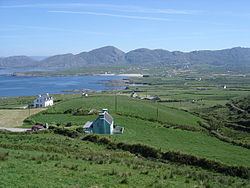Time zone WET (UTC+0) | Local time Sunday 12:43 PM | |
 | ||
Weather 9°C, Wind W at 42 km/h, 80% Humidity | ||
Allihies (/ælˈæhiz/; Irish: Na hAilichí, meaning "the cliff fields") is a coastal parish (and townland) in the west of County Cork, Ireland. The corresponding civil parish is Kilnamanagh. The largest village in the parish is Cluin, but is often mistakenly referred to by the name of the surrounding parish. Allihies Parish is located on the western tip of the Béara Peninsula and stretches between Cod's Head to the North West and Dursey Island to the South West. Allihies is 394 km by road from Dublin making it the furthest village in Ireland from the capital.
Contents
- Map of Allihies Co Cork Ireland
- Allihies beara co cork ireland a great place for a holiday in ireland
- History of copper mining
- Festivals
- Presidential visits
- Children of Lir legend
- References
Map of Allihies, Co. Cork, Ireland
Allihies beara co cork ireland a great place for a holiday in ireland
History of copper mining
From the Bronze age the area had been a site of copper-mining. In 1812 John Lavallin Puxley (1772-1856) established a company to operate the Berehaven copper mines at Allihies. During the following century, between 1812 and 1912, 297,000 tons of ore were recorded as passing through Swansea from Allihies mines. An attempt was made to restart mining in the late 1950s by a Canadian mining company, but was not progressed.
Daphne du Maurier’s novel Hungry Hill is a fictionalized saga of several generations of a mine-owning dynasty and based loosely on the history of the Puxley family.
There are three ruined Cornish engine houses visible from Allihies. The most prominent is the Mountain Mine man engine house, located on the mountain above the village and installed by the noted Cornish engineers Michael Loam and Son in 1862.
In the late nineteenth century newly developed sources of copper ore in Africa, the Americas and Australia were being worked. Following a resulting fall in the worldwide price of copper, the Allihies mine closed in 1884. The Berehaven area then saw large-scale emigration, as many of the miners who left Allihies found their way to newly-developing mining centres in the United States and Canada. Among these centres is Butte, Montana, where many families trace their ancestry to Allihies and the Beara peninsula.
Can-Erin Mines during the 1950s and 1960s dewatered the Mountain Mine and conducted evaluation drilling. The company noted that the Mountain Mine “has significant untested resource potential”
The Mountain Mine engine house has recently (2003) undergone conservation by the Mining Heritage Trust of Ireland. The completed conservation project and some of the underground mine workings were the subject of the TV documentary programme "Townlands" on RTÉ One in 2005.
Festivals
The annual Allihies Festival traditionally takes place on the 15th of August. It usually features horse racing - a practice probably dating from the time of more widespread use of horses and ponies in the copper mining industry. It takes place in a setting between the ocean and the surrounding mountains. The festivities now extend through the week and feature music, bale tossing and other events.
In 2008-9 the village also hosted the Michael Dwyer Festival of Traditional Irish music, which commemorates the life of a Beara musician and composer.
Presidential visits
In 2007 the parish was visited by the President of Ireland, Mary McAleese for the opening of the Allihies Copper Mine Museum, commemorating the area's mining heritage. The museum is housed in the chapel built by Cornish miners in 1845. The veins of copper at Allihies were discovered in 1812 and worked until 1884 and many Cornish mine captains, miners and craftsmen were employed alongside Irish people.
The village also attracted attention in June 1990 when it was chosen as one of the first places that Mary Robinson visited in her successful campaign for election as President of Ireland.
Children of Lir legend
The mythical story Children of Lir is well known in Ireland, with several areas claimed as the landing spot of the swans after their 900-year journey on the seas. One version of this oral tradition holds that the children of Lir were buried in Allihies. A site associated with this tradition is located near the village.
